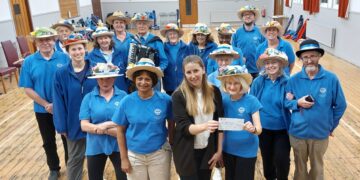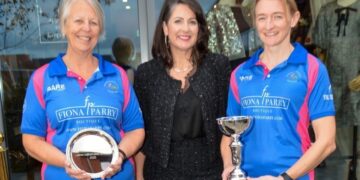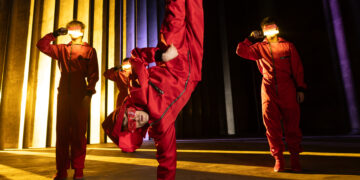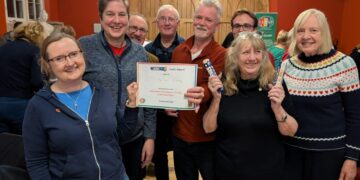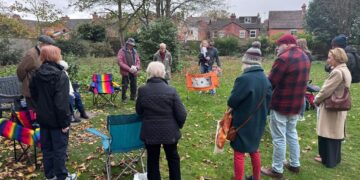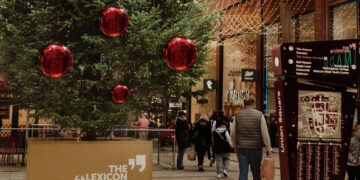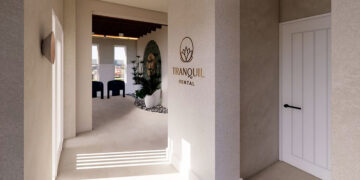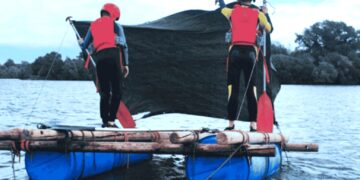TWO borough residents, from Wokingham and Winnersh, have joined with knitters and crocheters from around the world to create a woolen D-Day project on a huge scale.
Called The Longest Yarn, the crocheted artwork was inspired by The Bayeux Tapestry.
This ancient embroidered cloth is nearly 70 metres long and illustrates the events leading up to the Norman Conquest of England in 1066.
The Longest Yarn is 80 metres long, has 80 panels and depicts the events that took place in Normandy, on June 6, 1944.
It is worked entirely from yarn, with each panel showing different three dimensional scenes from the 1962 movie, The Longest Day.
It is a triumph of wool art, with contributions from knitters around the globe, including Anne Constable from Emmbrook and Judith Matthews from Winnersh, who both helped to create one of the panels.
Anne said: “It has been awe inspiring to contribute to this project.
“So many people have taken part, and it’s been wonderful to be a part of something so much bigger than we first imagined.”
The Longest Yarn was conceived by French knitter Tansy Forster, from Houesville, near Carentan.
She wanted to commemorate the 80th anniversary of the D-Day landings, and last year conceived the idea of making a memorial of the events of June 6, 1944 in crochet and knitting, inspired by the Bayeux Tapestry.
Anne, a member of The Barkham Hookers, first heard about the project nine months ago.
“Tansy had been inspired not only by the Bayeux Tapestry, but by UK post box toppers,” she explained.
“But they don’t have anything like post box toppers in France, so people there didn’t really understand what she was talking about.”
Instead, Americans, Canadians, Australians, New Zealanders, British, Americans in Europe – and one French knitter – quickly took up the challenge.
Anne was able to choose which panel to work on, and was drawn to an image of a church at Angoville-au-plain, in Normandy.
“Two young American medics set up an emergency first aid centre there,” she said.
“One of them had only had six weeks training.
“They took in anyone who needed medical attention, it didn’t matter what their nationality was.
“Over three days they treated 80 people, one of whom was German, and another a boy from the village.”

Anne’s father was a doctor, so she felt drawn to create this particular panel.
“It’s an amazing story,” she said.
“Apparently the church was hit by a bomb, which came through the roof and landed in the aisle.
“But it didn’t go off – although one of the medics did get a bump from some masonry when he took his helmet off.”
A window in the Angoville-au-plain church is dedicated to the two young medics, and Anne says that blood staines can still be seen on the church pews, from where it appears to be impossible to remove them.

“I got very involved with this whole story,” she continued.
“It’s so important to remember what happened, and I feel proud to have been able to contribute to this remarkable project.
“I hope that people will appreciate it, and be able to use it as a heartwarming means to show their respect.
“I learned a lot about D-day and summer of the people involved.
“The sacrifices that were made and the acts of bravery made me feel humbled, inspired and deeply thankful.
“It was also very enjoyable to work with so many other crafters from other countries.
“There were a few moments of panic and anxiety at having bitten off more than I could chew but it all came together in the end, and I’m very grateful to Judith for her help and support.”
Each individual panel was transported to Normandy, where the completed artwork was assembled.
It is currently on display, and free to view, inside Notre Dame Cathedral, in the small rural town of Carentan.
It will remain there until Sunday, September 1, after which it will be taken on an international tour, with its first destination Southwell Cathedral, Nottinghamshire.

It can be viewed there from Saturday, September 7 until Saturday, September 28.
Its scenes show the build up of events in England, the horrors on the Landing Beaches and the bloody inland battles.
It was carefully designed to be historically accurate, with some scenes depicting actual World War II veterans involved in the largest seaborne invasion in history.
The creation is free to view, and has drawn considerable media attention since its conception can For more information, visit: www.thelongestyarn.com, and www.normandythenandnow.com/the-scars-of-angoville-au-plain




